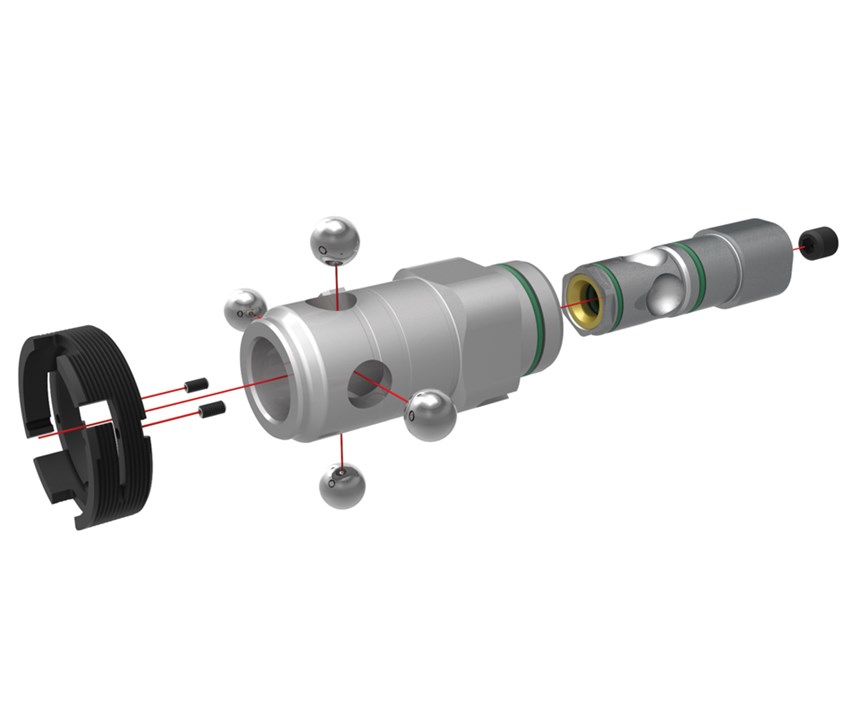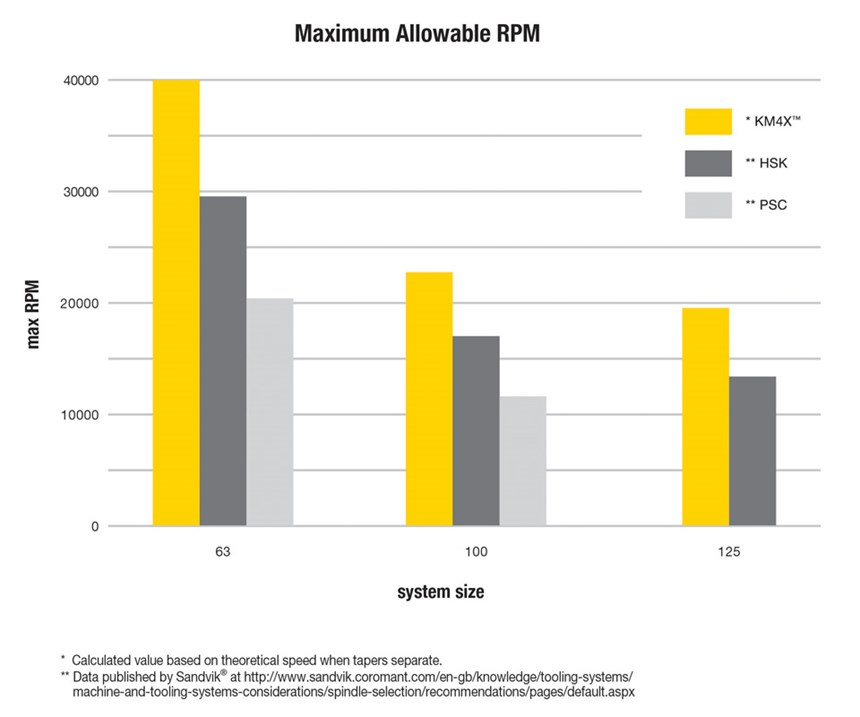The Next Step in Setup Reduction
Quick-change modular tooling is a clear way to increase productivity, shorten setup time and generally improve the bottom line for job shops and large manufacturers alike.
When machining tough materials such as titanium, machinists are challenged to maximize metal removal rates to achieve production efficiencies, yet they face low cutting speeds and considerably higher cutting forces. In response, and with advances in FEM and other analysis tools, machine tool builders have improved stiffness and damping on spindles and machine structures through the years to minimize undesirable vibrations that deteriorate part quality and tool life. These advances add to higher productivity, but the weakest point has often been the spindle connection itself.
The KM quick-change system from Kennametal Inc. was designed to address concerns about this weak point in the process. Quick-change modular tooling is a clear way to increase productivity, shorten setup time and generally improve the bottom line for job shops and large manufacturers alike. While the KM system has proven effective in this area for quite a while, the company has been expanding its lineup to address a broader machine tool platform.
Primary Advantages
Some systems may be able to transmit a considerable amount of torque, but cutting forces also generate bending moments that will exceed the interface’s limits before torque limits are exceeded. The combination of the KM4X system’s high clamping force and controlled interference levels lead to a robust connection, extremely high stiffness and restrained bending moment for improved performance in titanium machining.
The system is engineered for three times the bending moment resistant capacity compared with other tool systems. This design allows shops to use their high-performance machining centers to increase speeds and feeds in difficult machining applications, thus gaining the full potential from the machine tool.
Moreover, the ability to retrofit the spindle connection to an existing machine tool offers the added advantage of increasing throughput without having to invest in expensive additional capital equipment.
Existing Spindle Connections
The tool spindle interface must withstand high loads, yet maintain its rigidity. In most cases it will determine how much material can be removed on a given operation until tool deflection is too high or the onset of chatter is reached.
Several different types of spindle connections have been developed or optimized over the last few decades. Because of a good cost/benefit position, the 7/24 ISO taper became one of the most popular systems on the market. While it is used successfully in many applications, it has limitations in its accuracy and speed.
The advent of face contact represented a step forward over the standard 7/24 taper. The combination of face contact with 7/24 solid taper provides higher accuracy in the Z axis, but it lacks stiffness at higher speeds or with high side loads. Most of these tools on the market are solid, and the spindles have relatively low clamping force. Connection stiffness is limited, as radial interference needs to be kept to a minimum. Required tolerances to achieve consistent face contact are thus very tight, leading to higher manufacturing costs.
In the early 1980s, Kennametal introduced the KV system, which was a shortened version of CV tooling with a three-ball mechanism acting on a conical surface of a bore. Later versions were designed and sold with face contact. In 1985, Kennametal and Krupp Widia initiated a joint program to develop a universal quick-change system, now known as KM and recently standardized as ISO 26622. The polygonal taper-face connection known as PSC, now also standardized as ISO 26623, and the early 1990s HSK system started being employed on machines in Europe and later became standardized as DIN 69893, then ISO 121.
Development of KM4X
The original Boeing-inspired KM design was renamed a few years back as KM4X100—a spindle platform popular with a number of machine builders, as well as machine shops looking for high rigidity in demanding machining conditions. Kennametal recently added a 63-mm version to its product line aimed at a broader machine tool platform. Based on feedback from several machine builders regarding the KM4X product offering, the company continues to expand the portfolio, now including shrink-fit toolholders, HydroForce hydraulic chucks, TG and ER collet chucks and a variety of other spindle tooling, clamping units and modular adapters.
The most recent additions have been extensions in the 80- to 200-mm range and centerline turning tools to support mill-turn applications. According to Bill Redman, global product manager, tooling systems, KM4X’s rigidity allows for greatly increased gage lengths, allowing customers to reach much further without having to buy a special tool.
Restricting Bending Capacity
When machining tough materials such as titanium, cutting speeds are relatively low because of thermal effects on cutting tools. The latest spindles have been designed with abundant torque at low rotational speeds to better perform in these demanding applications.
The spindle connection must provide torque and limited bending capacity compatible with machine tool specifications and the requirements for higher productivity. It becomes obvious in end-milling applications, where projection lengths are typically longer. The limiting factor is the spindle interface’s bending capacity. As an example, an indexable helical cutter with 250-mm (9.84-inch) projection from spindle face, 80 mm (3.15 inches) in diameter, generates 4620 Nm (3407.5 foot-pounds) of bending moment and less than 900 Nm (663.8 foot-pounds) of torque.
The most critical parameters of a taper-face spindle connection are the clamping force and radial interference. Maximizing clamping force and selecting appropriate values of interference can further improve connection rigidity.
Related Content
Monaghan Compensation Chucks Convert Standard ER Holders
Diatool ER Hydraulic Compensation Chucks enable users to convert standard ER holders to a repeatable, steerable hydraulic chuck for more precise machining.
Read MoreTips for Choosing the Right Toolholder for High-Speed Machining
Here is some advice for shops hoping to maximize their efficiency performing high-speed milling operations.
Read MoreSeco Tooling Lineup Promotes Optimized Part Processing
The company’s expanded tooling lineup is aimed at applications ranging from general ISO turning to high-volume hard turning and deep-hole drilling.
Read MoreZoller Event Shines Lights on Shopfloor Connectivity
The company’s open house event highlighted smart manufacturing solutions from CAM to part.
Read MoreRead Next
Emerging Leaders Nominations Now Open
Here’s your chance to highlight a young person in your manufacturing business who is on the path to be a future leader moving your company forward.
Read MoreA Tooling Workshop Worth a Visit
Marubeni Citizen-Cincom’s tooling and accessory workshop offers a chance to learn more about ancillary devices that can boost machining efficiency and capability.
Read MoreDo You Have Single Points of Failure?
Plans need to be in place before a catastrophic event occurs.
Read More

























